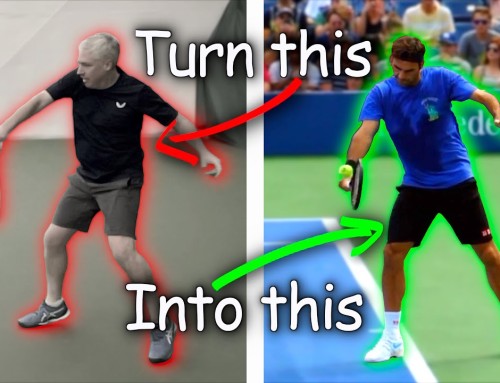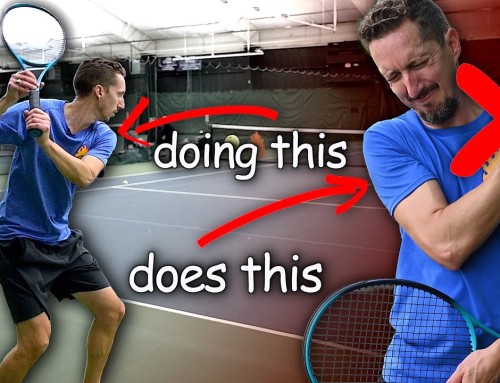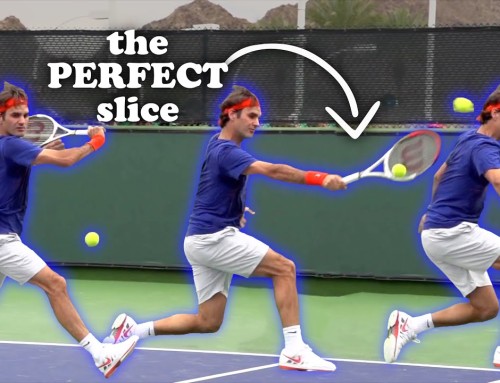I was working with a student on his backhand, and we discovered the only way to fix your two-handed backhand topspin — something that completely changed his shot in just one session.
The crazy part?
It’s something almost every amateur player gets wrong, and once you see it, you can’t unsee it.
We started by watching video of Novak Djokovic and Rafael Nadal hitting backhands. I asked my student a simple question: what angle is the racket face during their preparation?
His answer surprised me.
The strings were angled down. Not flat. Not open. Facing down toward the court.
Most recreational players do the exact opposite. They open their racket face during the take back, almost like they’re preparing to hit a slice. The problem with this is enormous, and most people never realize it’s sabotaging their topspin potential.
Here’s why this matters so much.
When your racket face is open during preparation, you’re creating a massive amount of extra work for yourself. Between the time you take your racket back and the moment you hit the ball, you’ve got to close that racket face to get it square. Otherwise, you’re launching the ball straight into the ceiling.
That’s a lot of moving parts to coordinate under pressure.
Think about it this way. When Rafa and Novak prepare with a closed racket face, they can drop their racket low below the ball and aggressively swing upward without any fear of launching it long. The closed face gives them that freedom. They can generate massive amounts of topspin because they’re swinging at a steep upward angle from way below the ball.
But when your racket starts open, you can’t afford to drop low and swing steeply upward. You’d send every ball sailing past the baseline.
So instead, you’ve developed a flatter, more horizontal swing path. You’re protecting yourself from your own technique.
My student’s backhand was traveling low and straight compared to his forehand, which had way more curve and safety. The reason was simple: on his forehand, he closed his racket before swinging upward. On his backhand, he was fighting to get the face square just in time to make contact.
This is the only way to fix your two-handed backhand topspin, and the fix was simpler than you might think.
First, we worked on taking the racket back with the face square or even slightly closed. Just a few degrees. Not dramatically closed, but definitely not open. This one change immediately set him up for success.
Second, we focused on dropping the racket head down to about knee height before swinging up toward the ball. With a closed face, this became possible. Before, he couldn’t drop that low because the open face would have sent balls flying.
The difference was immediate and dramatic.
After just a few practice swings, we started hitting balls. The sound was completely different. He felt it right away. That slippery feeling he’d had before was gone, replaced by the feeling of the strings really grabbing the ball.
We compared video of his old backhand to his new one. The old take back looked like he was preparing to hit a one handed slice. The new one looked like a professional player setting up for a topspin drive.
The transformation was that obvious.
Now here’s the hardest part about all of this, and it’s something every player needs to understand when they’re changing technique.
Your body is used to doing something different. You kind of have to make it do the new thing, and that feels robotic and weird at first. That’s completely normal. That’s the hardest part about changing technique.
The key is not letting yourself drift back to the old habit. If you keep letting your racket face creep open on the take back, you’ll find yourself right back where you started after a couple of weeks. Your old habit will pull you back because that’s just what you’re used to.
This is where most players fail. They learn the right movement, they practice it for a session or two, and then gradually slip back into their comfort zone.
If you want different results, you have to stay vigilant about maintaining the new pattern until it becomes your new normal.
So here’s what I want you to do. Next time you practice your backhand, check your racket face angle during your take back. Is it open like you’re preparing to hit a slice? If so, you’ve just identified why your backhand doesn’t have the spin and curve you want.
Work on taking it back square or slightly closed. Then focus on dropping your racket head low before swinging upward through contact. These two elements work together to create that professional topspin.
It’s not magic. It’s mechanics.
And once you see it, you can’t unsee it.
Your Coach,
Ian







